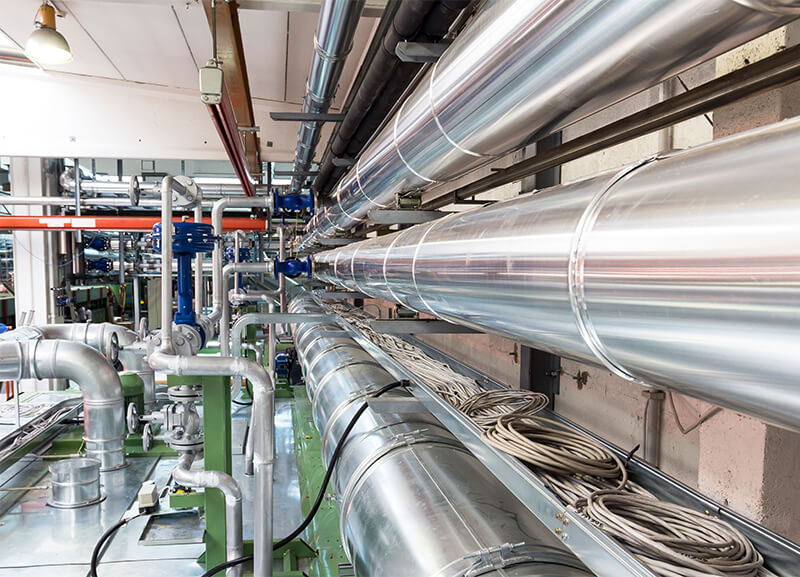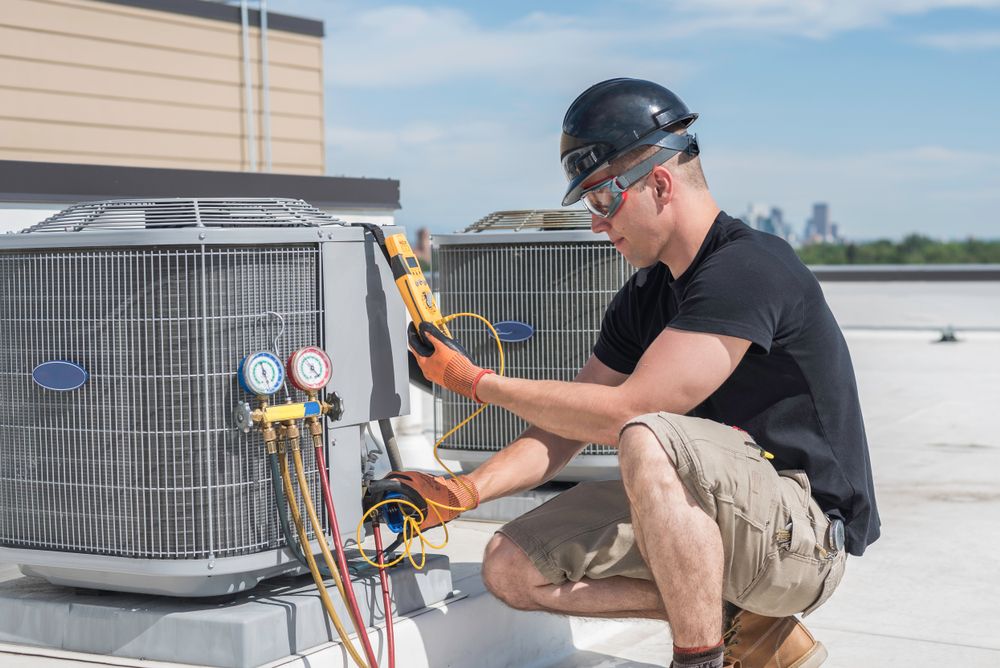Checking Out the Necessary Elements of an Efficient Heating And Cooling System
An efficient cooling and heating system is improved several essential parts that function in consistency. Each component, from the thermostat to the ductwork, plays a necessary role in preserving comfort and energy effectiveness. Understanding these aspects is essential for enhancing performance and boosting indoor air high quality. As one checks out these parts, the detailed connections between them reveal insights into enhancing general system efficiency. What particular factors add most to this effectiveness?
The Function of the Thermostat in Cooling And Heating Effectiveness

Often overlooked, the thermostat plays a critical function in the performance of Cooling and heating systems. This tiny tool functions as the main nerve center, managing temperature setups and making sure ideal convenience within a space. By accurately picking up the ambient temperature, the thermostat connects with the air flow, home heating, and air conditioning units to preserve the wanted environment
A reliable thermostat decreases power usage by activating the HVAC system only when required, therefore preventing too much heating or cooling. Modern programmable and wise thermostats boost this effectiveness additionally by permitting customers to set routines and remotely readjust settings, adjusting to day-to-day routines.
Additionally, the placement of the thermostat is essential; incorrect location can bring about inaccurate temperature analyses, causing inefficient operation. Overall, a well-functioning thermostat not only improves convenience but also contributes noticeably to energy financial savings and the longevity of the cooling and heating system.
Comprehending the Significance of Air Filters
Air filters serve a vital feature in HVAC systems by guaranteeing that the air circulating within an area stays healthy and clean. These filters catch dirt, allergens, and other pollutants, avoiding them from being recirculated throughout the atmosphere. By capturing these fragments, air filters add to improved indoor air quality, which can greatly benefit passengers' wellness, particularly those with allergic reactions or respiratory system problems.
Additionally, keeping clean air filters improves the efficiency of a/c systems. Stopped up filters can restrict air flow, creating the system to function tougher to preserve wanted temperatures, causing boosted power usage and greater utility bills. Regularly replacing or cleaning filters is an essential upkeep step that can extend the life-span of cooling and heating equipment. Eventually, understanding the importance of air filters allows property owners and building supervisors to take proactive actions to guarantee a well-functioning, efficient a/c system that promotes a safe and comfy interior environment.

The Functionality of the Heating System and Heatpump
Furnaces and heatpump are vital components of heating and cooling systems, in charge of giving heat throughout colder months. Heaters operate by heating air with combustion or electric resistance, after that distributing it throughout the home by means of ducts. They usually offer quick heating and can be sustained by gas, electrical power, or oil, depending upon the system type.
Conversely, heatpump move warm as opposed to produce it. They extract warmth from the outdoors air or ground, also in low temperature levels, and transfer it inside. HVAC experts. This double functionality allows heatpump to also provide air conditioning in warmer months, making them functional alternatives for year-round climate control
Both systems require appropriate maintenance to assure performance and longevity. While heating systems master severe cold, heatpump can be advantageous in modest climates. Comprehending their unique performances aids property owners in selecting one of the most ideal choice for their home heating needs.
Checking Out the Cooling Device
The a/c device is an important part of cooling and heating systems, readily available in various kinds to fit various demands. Comprehending the efficiency rankings of these units is vital for making notified choices about energy consumption and cost. This area will certainly check out the diverse kinds of ac unit and clear up just how efficiency ratings effect performance.
Kinds of Air Conditioners
While numerous factors affect the selection of air conditioning systems, recognizing the different kinds readily available is important for house owners and building managers alike. Central air conditioners are designed to cool down whole homes or structures, making use of a network of ducts for airflow. Window units provide a more localized solution, ideal for small areas or single spaces. Portable a/c supply flexibility, permitting customers to move the device as required. Ductless mini-split systems are an additional choice, incorporating the effectiveness of main systems with the comfort of zoning, as they require no ductwork. Ultimately, geothermal systems harness the planet's temperature for energy-efficient cooling. Each type features distinctive advantages, making educated choices crucial for reliable climate control.

Performance Rankings Described
Comprehending effectiveness ratings is necessary for choosing the best cooling system, as these metrics offer insight right into the system's performance and power intake. One of the most common score for ac system is the Seasonal Power Efficiency Proportion (SEER), which gauges the cooling output throughout a regular cooling season separated by the complete electric energy input. A higher SEER shows better performance. Furthermore, the Power Performance Proportion (EER) is used for determining performance under specific problems. An additional essential metric is the Energy Star certification, which represents that an unit fulfills stringent power effectiveness guidelines. By assessing these rankings, customers can make informed options that not only enhance convenience yet additionally minimize power prices and environmental impact.
The Significance of Ductwork and Air movement
Reliable ductwork style and air flow monitoring play essential duties in the overall effectiveness and performance of cooling and heating systems. Appropriate ductwork assurances that conditioned air is dispersed uniformly throughout an area, decreasing temperature level variations and enhancing convenience. Properly designed air ducts reduce resistance to airflow, reducing the work on cooling and heating tools and eventually decreasing power intake.
Air flow monitoring includes strategically positioning vents and signs up to boost the flow of air. This avoids typical issues such as cold or warm spots, which can take place when air flow is blocked or improperly balanced. Additionally, the appropriate air duct products and insulation can further boost efficiency by reducing warm loss or gain throughout air transportation.
An effective ductwork system not only adds to energy cost savings but can additionally prolong the life-span of cooling and heating tools by minimizing unneeded stress (HVAC experts). Understanding the importance of ductwork and airflow is crucial for attaining peak A/c system efficiency.
Normal Upkeep Practices to Improve Performance
Normal maintenance techniques are vital for ensuring peak efficiency of cooling and heating systems. These techniques include regular evaluations, cleaning, and essential repair services to keep the system running successfully. Regularly transforming air filters is crucial, as blocked filters can block airflow and decrease efficiency. Furthermore, specialists need to check and clean evaporator and condenser coils to prevent overheating and power wastage.
Annual specialist assessments are also advised, as trained professionals can recognize possible problems before they escalate. Lubricating moving parts decreases wear and tear, adding to a much longer life-span for the system. Ensuring that the thermostat works appropriately aids in keeping perfect temperature level control.
Frequently Asked Questions
Just how Typically Should I Replace My Thermostat?
Thermostats need to typically be replaced every 5 to ten years, relying on use and modern technology advancements. Regular checks are a good idea to assure peak efficiency, specifically if experiencing irregular temperature level control or boosted power here prices.
What Dimension Air Filter Is Best for My HVAC System?
The most effective dimension air filter for a HVAC system differs by unit design. Normally, it's vital to consult the owner's guidebook or examine the existing filter measurements to assure peak efficiency and air high quality.
Can I Install a Heatpump Myself?
Mounting a warm pump individually is feasible for knowledgeable people, yet it calls for knowledge of electric systems and neighborhood codes. Employing a specialist is suggested to ensure proper setup and optimal system efficiency.
How Do I Know if My Ductwork Is Efficient?
To establish ductwork efficiency, one need to look for leaks, procedure air flow at vents, examine insulation quality, and evaluate temperature level distinctions between supply and return air ducts. Specialist analyses can offer extensive insights into overall efficiency.
What Are Signs My Heating And Cooling Demands Immediate Maintenance?
Signs that a HVAC system needs prompt maintenance consist of unusual sounds, inconsistent temperatures, raised energy bills, undesirable smells, and constant cycling. Addressing these concerns without delay can stop further damages and guarantee optimal system performance.
Air filters offer a vital feature in HVAC systems by assuring that the air distributing within a room remains healthy and balanced and tidy. In addition, maintaining clean air filters boosts the efficiency of A/c systems. Ductless mini-split systems are one more alternative, integrating the performance of central systems with the comfort of zoning, as they require no ductwork. Comprehending performance scores is necessary for selecting the best air conditioning device, as these metrics provide understanding into the system's efficiency and power intake. The best dimension air filter for a Cooling and heating system varies by unit style.